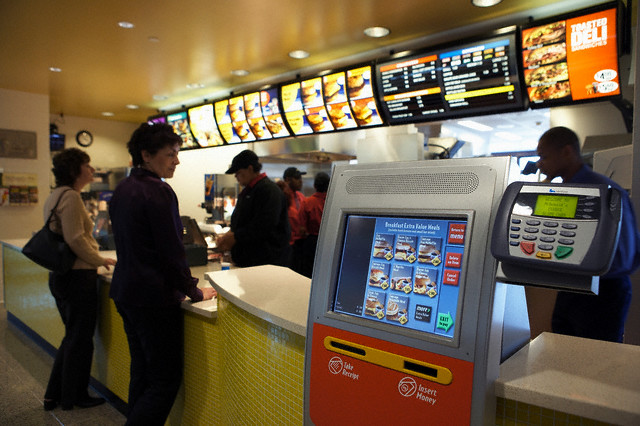
The future is coming to McDonald’s and, according to recent reports, that future is going to look a lot like self-service order kiosks.
According to Inc., the days of being asked “would you like fries with that” are coming to an end. Instead of a human cashier inquiring, the machine will simply pop up a fries notification.
McDonald’s, which has increasingly expanded its use of self-service kiosks in the last year, says they are popular with consumers who like the ability to customize their orders more efficiently and easily. Customers are also, according to McDonald’s, quickly becoming used to waiting to pick up their orders at the counter — or waiting for a member of the staff to serve it to them at their table.
According to the Bureau of Labor and Statistics, those self-service kiosks will soon be replacing a large share of the human workforce. Their figures estimate that about 80,000 fast food jobs will disappear by 2024. TheStreet cites that “half of U.S. McDonald’s will have the self-serve kiosks by the end of 2018, at a cost of about $2.4 billion.”
A review of using the kiosk turned up something of a split decision. The writer for Inc. noted that some — particularly older consumers — are going to find ordering via kiosk a bit unnerving and somewhat like talking to an automated voice when trying to pay their phone bill. This, the review noted, is the same type of customer likely to wonder why anyone on Earth would want a car that drives itself.
“But if you enjoy tapping on a device to consume everything from news to shopping to social media, using a self-serve kiosk will probably seem faster and more intuitive, even if doing so means the demise of jobs for minimum wage workers,” the article concluded, rather dramatically.
But correctly? Well, that is bit more of an open question.
One operating assumption, for example, is that when kiosks enter a QSR space, time is basically up for the cashiers behind the counter. That is, perhaps, a less than foregone conclusion.
When Shake Shack tried that exact set-up with digital kiosk-ordering only — no cash, no cashiers — customers answered back loudly with “no thanks.” The experimental digital-only store was a bit of a flop as consumer complaints erupted on social media that the brand was pushed toward a rapid about face.
“In the first rollout at Astor Place, we did not accept cash at all, and there are people who have told us very clearly ‘we want to pay with cash,’’’ Shake Shack CEO Randy Garutti told stock market analysts of the decision. “So, in this next phase, we’re going to go ahead and have cashiers as well as kiosks.”
Some customers like kiosks, some don’t — and QSRs probably aren’t looking to run off all those customers in the next five years. That doesn’t mean the need for cashiers won’t fall, but it might be a bit of an exaggeration to say that the era of minimum wage jobs is over because of kiosk automation. Moreover, capturing the jobs that will be lost does not necessarily offer up the full count on jobs that will be created. The simplest example is that McDonald’s stores that eliminate cashiers still need human help, in case there is an issue with the machine — or to simply deliver the food to tables.
And, of course, the machines cannot make the food.
Automation — it can be fairly said, will change a lot of industry, and QSR food service appears to be on that list. There may be a need for fewer cashiers going forward, but what job automation creates, or the roles it redefines, are yet to be seen.
Things are changing for the American minimum wage worker, and some of those changes will have negative side effects. That said, it still might be a bit soon to start writing that obituary.